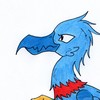HOME | DD
 Olmagon — Harassed By Huge Hawks
Olmagon — Harassed By Huge Hawks

#animal #bird #birddrawing #birdsofprey #cenozoic #cuba #digitalart #digitaldrawing #digitalillustration #digitalpainting #eagle #flight #flying #forest #hawk #holocene #paleoart #paleontology #pleistocene #raptor #roost #sloth #acratocnus #paleoillustration #accipitrid #buteogallus #gigantohierax #megalocnidae #galerocnus
Published: 2021-11-04 22:52:48 +0000 UTC; Views: 20275; Favourites: 189; Downloads: 4
Redirect to original
Description
12,000 years ago during the end of the Pleistocene epoch over the forests of Cuba, a massive bird of prey almost 1.3 meters long from head to tail known as the Suarez's giant eagle (Gigantohierax suarezi) has just managed to kill a prehistoric sloth of the species Galerocnus jaimezi/ Acratocnus antillensis, which is quite larger than any extant sloths, and the bird starts carrying off its kill. However, the gigantic raptor is soon alerted that it is hunting in the territory of a mating pair of smaller (but still large) hawks of the species Buteogallus borrasi. The smaller raptors do not enjoy the presence of a large eagle around their home range that could threaten them and their nest, so one of the Buteogallus starts pecking and plucking the Gigantohierax to annoy it into leaving, while the second member of the pair makes a quick stop and perches on the sloth carcass which is still in the eagle's clutch, hoping to quickly steal a few scraps of meat to eat. Being mobbed by a smaller hawk while carrying a heavy sloth carcass, it is taking the Suarez's giant eagle all its might to keep ahold of its meal.Thatonewildlifelover (www.deviantart.com/thatonewild… ) asked me to make some art of Gigantohierax on the comments of this drawing (www.deviantart.com/olmagon/art… ) so here we are and I made this. Was also partly inspired by this photo of a blackbird roosting on a stick carried by an osprey (www.thisiscolossal.com/2021/05… ) to have a hawk perch on the sloth carried by an eagle.
Wildlife on islands tends to be particularly interesting as the wildlife evolving in isolation from the rest of the world there often evolves unique features for their own unique habitats. Unfortunately, being so specialized also makes island fauna more vulnerable to extinction when habitat changes or invasive species like humans arrive. When mankind started spreading across the planet and invented boats and rafts to even reach isolated islands, many island ecosystems were severely hit and many of their species died out soon after humans reached them. New Zealand and Madagascar are comparatively well-known examples of this, the former losing moas, adzebills, Haast's eagle etc while the latter lost its giant lemurs and elephant birds. The extinct fauna of the islands in the Caribbean Sea are way underrepresented, with Cuba in particular having a pretty good fossil record of its lost wildlife.
While it is a very obscure prehistoric animal, Gigantohierax suarezi was quite an interesting creature that once lived in Cuba. Described in 2002, it is also called the Suarez's giant eagle or Cuban giant hawk, the animal is given names with 'giant' in them for a reason. Known from fossil remains of the legs, the femur of Gigantohierax was similar in size to that of the extinct Haast's eagle of New Zealand. Haast's eagle had a body length of 1.4 meters and weighed around 15 kilograms, making it the largest eagle ever known, and Suarez's giant eagle would have only been slightly smaller than this. The Haast's eagle has a rather short wingspan for its size of 2.6 meters because it was a forest bird whose short wings help it fly around branches better. Wing remains of Suarez's giant eagle aren't known, but if it had "normal" eagle wing proportions then it may have had a larger wingspan than the Haast's eagle. Structures of the leg bones suggest Suarez's giant eagle may have been better-adapted to walking than most eagles, though this doesn't necessarily mean it hunted on foot. With its sheer size and Cuba's lack of large mammalian predators, the eagle would have been one of the main apex predators on the island that probably preyed upon large rodents called hutias (which still exist today) and some extinct species of sloths, as well as large birds such as the extinct Cuban flightless crane (Antigone cubensis). Unfortunately Gigantohierax is a really obscure animal and I can barely find information on it anywhere online and then there's these two dudes on Reddit arguing fiercely about its size and habits further confusing me which info was right (www.reddit.com/r/Naturewasmeta… , btw I do agree with ElSquibbonator that NoDemand1519 was being unnecessarily rude).
Suarez's giant eagle was not Cuba's only large extinct bird of prey. In 1970 a species of large raptor comparable in size to the extant golden eagle was described based off fossil material from the legs, and was named Aquila borrasi and placed in the genus Aquila alongside some extant large eagles like the golden and wedge-tailed eagles. However in 1982 the remains were found to be quite different from Aquila eagles, size being the only similarity. The animal was given the new name Titanohierax borrasi, and was moved to the extinct genus Titanohierax which had already contained another extinct bird of prey species called Titanohierax gloveralleni that lived in the Bahamas at around the same time. Due to this history, some sources state the Titanohierax genus lived in Cuba and the Bahamas, but borrasi got put back in the Aquila genus in 2004 so currently Titanohierax is only known from the Bahamas. Being the classification nuisance it is, borrasi was moved to another genus again in 2007, this time placed in the genus Buteogallus which to this day is still believed to be the correct placement and it now goes by the name B. borrasi. The genus Buteogallus today contains several living species, the largest being the great black hawk, but B. borrasi was around a third larger than a great black hawk making it very large for the genus bit still smaller than Suarez's giant eagle. Actually, some larger fossil material once assigned to B. borrasi has since been found to be remains of Gigantohierax instead, but even so borrasi remains the most common fossil accipitrid in Cuba.
An extinct family of sloths, the Megalocnidae were found in the Caribbean islands up until around just 5,000 years ago. Closely related to the megalonychid ground sloths from mainland North and South America, the megalocnids were hugely diverse, ranging in size from less than 10 kilograms (smaller than extant tree sloths) to around 90 kilograms (about sheep-sized) depending on the species, and while some species climbed trees others lived on the ground. However, the classification of the megalocnids is also quite a mess, with many very obscure genera and species having been named based off poor remains and then synonymised and split from each other around. I chose to portray a megalocnid sloth as the prey animal, intended to be of the species Galerocnus jaimezi, after I learned about the animal through Joschua Knuppe's Cuban fauna size chart (mobile.twitter.com/joschuaknup… ). However upon a simple Google search of the animal's name, I found barely any information on size, habits or just anything at all. One single result stated the animal was an arboreal species that climbed trees (www.deviantart.com/yosoyelhomb… ) but I don't know if that's true or where the guy even got that info. Some other sources state that Galerocnus has been found to be the same animal as Acratocnus antillensis and was synonymised with it, but once again I'm not sure if this is true so the taxonomy of the sloth here is a mess.
Related content
Comments: 20

👍: 0 ⏩: 1

👍: 2 ⏩: 1

👍: 1 ⏩: 0

👍: 2 ⏩: 1

👍: 1 ⏩: 1

👍: 0 ⏩: 0

👍: 1 ⏩: 2

👍: 1 ⏩: 0

👍: 0 ⏩: 0

👍: 1 ⏩: 1

👍: 1 ⏩: 1

👍: 1 ⏩: 0

👍: 0 ⏩: 1

👍: 0 ⏩: 0

👍: 1 ⏩: 1

👍: 1 ⏩: 1

👍: 0 ⏩: 0

👍: 0 ⏩: 1

👍: 1 ⏩: 0

















